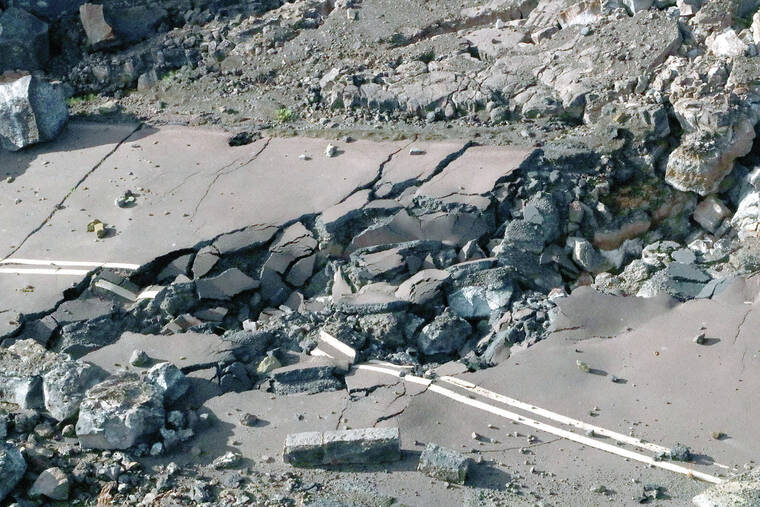Volcano Watch: The Great Hawaii ShakeOut and the earthquake energy budget
The Great Hawaii ShakeOut is a yearly event for kama‘aina and visitors to practice and prepare for when a large damaging earthquake hits the Hawaiian Islands. Every year, an earthquake drill happens on the third Thursday of October. This year, the ShakeOut is set for 10:19 a.m. on Oct. 19.
“Drop! Cover! Hold on!” is the ShakeOut motto. But why? None of those actions can stop the shaking brought on by seismic waves rolling through wherever you are.
ADVERTISING
We drop to lower our center of gravity, so that it is more difficult for us to be thrown down by the ground that is violently moving in several different directions.
We take cover under something secure, like a sturdy desk or a thick bed mattress, to protect ourselves from objects that might fall or topple over, like ceiling fans, bookshelves or televisions. If no cover is readily available, cover your head with your arms — some protection is better than no protection.
We hold on to sturdy fixtures, like a desk or table leg, so our cover stays with us, since the ground is moving up-and-down and side-to-side.
Here in Hawaii, thousands of earthquakes happen every year. Kama‘aina and visitors might notice that the feeling of shaking is not always the same, even for earthquakes of similar magnitudes and that are just as far away.
This is because shaking is just one way that an earthquake releases energy. Earthquake energy is also released thermally and mechanically. This means there are three categories that comprise the “earthquake energy budget,” or the total energy released by an earthquake.
During an earthquake, rocks break and then slide past each other to release the built-up stresses imposed on them by tectonic or magmatic forces.
When rocks slide against each other, friction generates heat along the sliding surfaces. We are familiar with this, as it’s what warms our hands when we rub them together in cold weather. A portion of the total earthquake energy budget is spent thermally as the surrounding rocks generate heat sliding against each other.
Another byproduct of rocks sliding against each other is broken bits of rocks along the sliding surface. This is similar to the sawdust generated when sandpaper moves across a plank of wood, or the little bits of rubber that come off when erasing pencil marks on paper. A portion of the total earthquake energy budget is spent in mechanical wear, as surrounding rocks are broken.
The last part of the earthquake energy budget is the one that affects most people, the radiated energy. The energy spent on heating and breaking the surrounding rocks only affects the immediate area of the fault, which is usually deep underground and has little relevance to humans that live on the surface.
Whatever portion of the total energy budget that is not spent on heating and mechanical wear is released as “radiated” energy, which refers to the seismic waves that are radiated from the parts of the fault that slipped. This is the ground motion we feel on the surface during an earthquake.
Every earthquake spends its total energy budget on these three things, but not in equal or constant portions.
Earthquakes of the same magnitude (meaning they have the same total energy budget) may spend energy in different ways. One earthquake may spend most of its energy mechanically pulverizing little bits of the fault. Another earthquake (perhaps on a more well-developed fault) might spend more on thermal heating or shaking the ground.
That is why ground motion is not always comparable across earthquakes with similar magnitudes. An earthquake that uses the bulk of its energy into radiated energy might cause more shaking than a same-magnitude earthquake that spends all of its energy heating and breaking the surrounding rocks.
With that said, if you feel the rumble of an earthquake, it is always a good idea to “Drop, cover and hold on!”
For practice, please join the USGS Hawaiian Volcano Observatory at 10:19 a.m. this Thursday, Oct. 19, as we participate in The Great Hawaii ShakeOut. For more information on how your ohana or business can participate, see https://www.shakeout.org/hawaii/.
Volcano activity updates
Kilauea is not erupting. Its USGS Volcano Alert level is ADVISORY.
The area just south of Kilauea’s summit continues to show signs of elevated unrest, though at decreased rates. Rates of inflationary tilt in the area south of the Kilauea summit caldera are beginning to level off. Seismicity in the region south of Kilauea caldera summit continues, though at decreased rates from the peak in activity on Oct. 6. The most recent sulfur dioxide (SO2) emission rate, of approximately 100 tonnes per day, was measured on Oct. 6.
Mauna Loa is not erupting. Its USGS Volcano Alert Level is at NORMAL.
Webcams show no signs of activity on Mauna Loa. Seismicity remains low. Summit ground deformation rates indicate slow inflation as magma replenishes the reservoir system following the recent eruption. SO2 emission rates are at background levels.
One earthquake was reported felt in the Hawaiian Islands during the past week: a M2.6 earthquake 1 km (0 mi) WSW of Pahala at 35 km (22 mi) depth at 7:13 p.m. HST on Oct. 11.
HVO continues to closely monitor Kilauea and Mauna Loa.
Please visit HVO’s website for past Volcano Watch articles, Kilauea and Mauna Loa updates, volcano photos, maps, recent earthquake information, and more. Email questions to askHVO@usgs.gov.
Volcano Watch is a weekly article and activity update written by U.S. Geological Survey Hawaiian Volcano Observatory scientists and affiliates.


